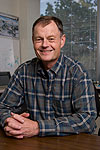Happy anniversary, Tevatron
Roger Dixon, head of the Accelerator Division, wrote this week's column.
 |
|
Roger Dixon
|
On Monday morning, October 14, 1985, the Accelerator Division's Early Bird report, issue no. 1177, stated: "A fitting conclusion to this year's run has been the successful production, accumulation, and acceleration of antiprotons to 800 GeV, and the detection of proton-antiproton collisions in the CDF Detector at B0."
So began the era of the Tevatron collider. Observing the first collisions 25 years ago was a pivotal moment in the laboratory's history. It completed the first bold step toward a prodigious future of collider physics at Fermilab.
The Tevatron accelerator-at that time also known as the Energy Doubler and the Energy Saver-had been accelerating beam for about two years in 1985, supplying protons to a contingent of large fixed-target experiments that had evolved from the fixed-target program associated with Fermilab's original Main Ring accelerator.
Work on the Tevatron-the world's first superconducting accelerator-had begun in earnest in the late 1970s. The construction and installation of the accelerator was a major effort for the laboratory. Busy testing the cryogenic systems and installing superconducting magnets in the beam line, some of the laboratory's venerable staff had difficulty believing that an entire ring of 1,000 superconducting magnets would ever work. It was not uncommon to overhear outrageous bets being proffered concerning the outcome of these efforts. Fortunately, no one ever called in any of these bets when the machine worked as planned: there would have been some very embarrassing moments involving improper behavior.
If some people did not have confidence in the machine, they certainly had confidence in the project's leadership. Helen Edwards was key to the success of the Tevatron (See first photo in middle column). She drove the effort hard, and she was a meticulous taskmaster. She knew that it could be done, and she was very credible to the people in the trenches, where she spent much of her time. Everyone worked hard for her, and together they achieved an exceptional outcome.
The Antiproton Source, a major facility in its own right, also had to be built before collisions could occur. Groundbreaking took place in August 1983, and the facility was up and running in 1985. Many people made significant contributions to this effort as well. It is impossible to list all the work that went on to make the collisions a reality.
It took both leadership and technical talent to arrive at this point in history. May we continue to have an abundance of these attributes to take us into the future.
|